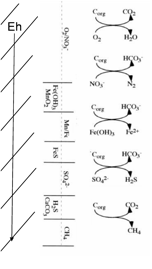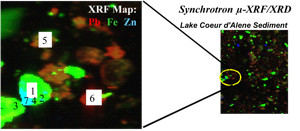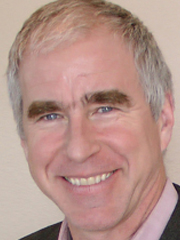Biogeochemical Cycling
Prior Funding: Biogeochemical Cycling of Heavy Metals in Lake Coeur d’Alene Sediments: The Role of Indigenous Microbial Communities, NSF-EAR Project 0628258 2002-2009.
Students/Postdocs: Sevinc Sengor, Arash Massoudieh, Prof. Petros Gikas/ Tech. U. Crete, Eileen Belding (graduated MSCE), KC Curthoys (graduated BSCE, Valedictorian), Karen Lam Fat Cheong Him (graduated MSCE), Montarat Na Issangkarun (graduated MSCE).
Collaborators: Brent Peyton/ Montana State; Rajesh Sani/S. Dakota SMT; Nic Spycher/LBL; Petros Gikas/Tech. U. Crete; Dusan Zagar/J. Stefan Inst., Ljubljana, Slovenia; Sevinc Sengör/ SMU; Arash Massoudieh/Catholic Univ. America.
Redox Sequence micro-XRF image of lake sediments Sampling at Lake Coeur d’Alene
Project Summary: The mobility of metals in riverine, estuarine, and lacustrine sediments is affected by multiple coupled biotic and abiotic geochemical processes that reflect redox disequilibrium and cannot be modeled using conventional equilibrium-based models. Competing mechanisms in these environments include the mobilization of sorbed metals by reductive dissolution of Fe(III) (hydr)oxides and the precipitation of metal sulfides upon reaction with biogenic sulfide. In addition, the toxicity of metals in polluted environments can have a significant effect on microbial activity and thus indirectly affect metal biogeochemical behavior. We are investigating these processes with mathematical modeling and data from several locations including Lake Coeur d’Alene, Idaho (e.g., Moberly et al., 2009), an area heavily impacted by upstream mining activities, and sediments from several DOE-managed sites including Rifle, Colorado. Model results for Benthic cycling of heavy metals at Lake Coeur d’Alene (e.g., Sengör et al., 2007) indicate that the relative rates of Fe(III) versus sulfate reduction may be an important factor controlling pH and types of Fe(II) minerals precipitation at depth. Upon reductive dissolution of Fe(III) hydroxides, numerical experiments indicate that a delicate balance takes places between FeS and FeCO3 precipitation, which compete for aqueous Fe(II), and the formation of aqueous (bi)sulfide complexes, which compete with the precipitation of FeS and other metal sulfides for biogenic sulfide.
We have extended this modeling approach that seeks to incorporate comprehensive chemical and microbially-mediated transformations to interpret lab data on U reoxidation (Singh et al., 2014; Spycher et al., 2011), as well as data from lab experiments in toxic effect of exposure of microbial species to heavy metals (Sani et al., 2010; Sengör et al., 2012). These simulations utilize the exposure-time concept developed in Ginn (1999) for the accounting of cumulative dose acquired by motile microbial species that undergo attachment/detachment to solid surfaces.
Important Papers in this Topic:
- Singh, G., S. S. Sengör, A. Bhalla, S. Kumar, J. De, B. Stewart, N. Spycher, T. R. Ginn, B. M. Peyton, R. Sani, Reoxidation of biogenic reduced uranium: A challenge toward bioremediation, Critical Reviews in Environ. Science and Technology, 44:391-415, 2014.
- Sengör, S. S., T. R. Ginn, C. J. Brugato, P. Gikas, Anaerobic microbial growth near thermodynamic equilibrium as a function of ATP/ADP cycle: The effect of maintenance energy requirements, Biochemical Engineering J., 81:565-72, 2013.
- Sengör, S.S., Gikas, P., Moberly, J. G., Peyton, B. M., Ginn, T. R., Comparison of single and joint effects of Zn and Cu in continuous flow and batch reactors, J. Chemical Tech. & Biotech. 87(3):374-380, 2012.
- Spycher, N.F., Issarangkun, M., Stewart, B.D., Sengör, S. S., Belding, E., Ginn, T.R., Peyton, B.M., Sani, R.K., Biogenic uraninite precipitation and its reoxidation by iron(III) (hydr)oxides: A reaction modeling approach, Geochimica et Cosmochimica Acta, 75 (16), pp. 4426-4440, 2011.
- Sani, R.K., Rastogi, G., Moberly, J.G., Dohnalkova, A., Ginn, T.R., Spycher, N., Shende, R.V., Peyton, B.M., The toxicity of lead to Desulfovibrio desulfuricans G20 in the presence of goethite and quartz, J. Basic Microbiology, 50(2):60-170, 2010.
- Moberly, J. G., T. Borch, R. K. Sani, N. F. Spycher, S. S. Sengor, T. R. Ginn, B. M. Peyton, Heavy Metal-Mineral Associations in Coeur d’Alene River Sediments: A Synchrotron-Based Analysis, Water Air and Soil Pollution, 201(1-4):195-208 July 2009.
- Rastogi, G., R.K. Sani, B. M. Peyton, J. Moberly, T. R Ginn, Molecular Studies on the Microbial Diversity Associated with Mining-Impacted Lake Coeur d’ Alene Sediments, Microbial Ecology, 58(1):129-139 July 2009.
- Sengor, S. S., S. Barua, P. Gikas, T. R. Ginn, B. M. Peyton, R. Sani, N. Spycher, Influence of Heavy Metals on Microbial Growth Kinetics Including Lag Time: Mathematical Modeling and Experimental Verification, Environmental Toxicology and Chemistry, 28(10):2020-2029, 2009.
- Sengor, S. S., N. Spycher, T. R. Ginn, R. K. Sani, B. Peyton, Biogeochemical reactive-diffusive transport of heavy metals in Lake Coeur d’Alene sediments, Applied Geochemistry, 22(12): 2569-2594, 2007.
- Ginn, T.R. On the distribution of generalized exposure-time in groundwater flow and reactive transport: Foundations; formulations for groundwater age, geochemical heterogeneity, and biodegradation, Water Resour. Res., 35(5):1395-1408, 1999.








